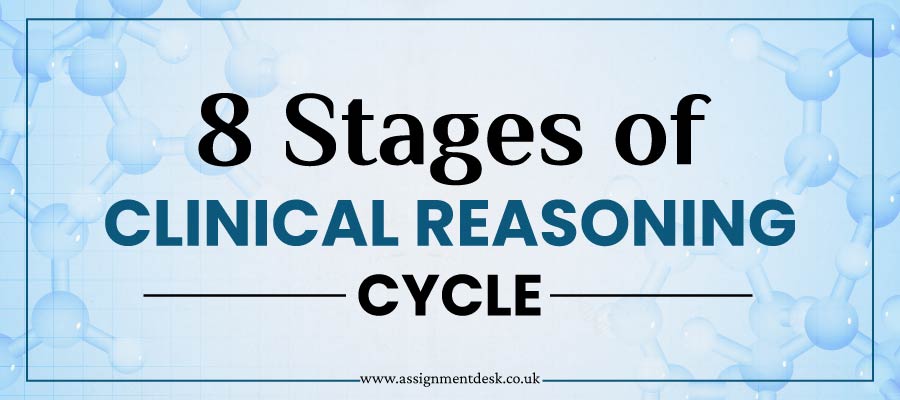Clinical Reasoning Cycle: Definition, It's 8 Phases & Benefits in Nursing Industry
22 Feb 2022 2799
Table Of Contents
Are you a medical or nursing student? If yes, you must've heard about the clinical reasoning cycle many times during your academic life. You must have also known about it a little bit. It is a process used by nurses and medical staff to take care of the patient.
Anyways, a nursing student has to go through the depth of this cycle. The student has to understand every aspect of this to know how the process goes in the patient's treatment. This cycle defines the entire process from collecting the data to reflecting upon them. Therefore, every student has to learn about the cycle's stages in the nursing industry.
Anyways, to carry out the process of Levett Jones's clinical reasoning cycle carefully, the nurses who work on a patient need to describe that they were in an organized state while treating him. In the nursing industry, these people who take care of patients need to be alert and careful to analyze each phase to get accurate results and judgments.
Therefore, a student who has just entered the medical college needs to understand this cycle in-depth with its 8 phases. Also, they have to write assignments on it. So, before knowing the steps of the process, first, let's learn about the clinical reasoning cycle definition and its benefits.
What Is the Clinical Reasoning Cycle?
Clinical Reasoning is the cognitive process employed by clinicians, nurses, and other medical staff to analyze a patient's condition, find the disease, and create a treatment plan.
In simple terms, the clinical reasoning cycle refers to how a nurse or other medical staff use their knowledge to understand the culture and medical ethics to know the patient's health and initiate the course of medicine. Sometimes, clinical reasoning is defined as critical thinking, clinical judgment, problem-solving, and decision-making.
Moreover, the reasoning cycle is an educational model designed for nursing students. This cycle aims to tell the students and provide them with the necessary practices required to handle patients. Further, Levett-Jones described it in 2009. The clinical reasoning cycle proposed by him involves 8 phases. By this cycle, a health care person systematically cures the patient.
Now, you must know about the clinical reasoning cycle; after that, let's learn its benefits.
Clinical Reasoning: Why It Is an Important Aspect in Nursing?
Every health care industry uses this clinical reasoning cycle to treat the patient. However, if the industry does not use this cycle, they can not excel in this profession because the patient's health is at risk and death in some cases.
But the health care industry that uses this cycle emerges so many benefits. So, let's go through why the clinical reasoning cycle is an essential aspect of nursing.
- This cycle helps the nursing students or nurses to make a timely diagnosis.
- It helps in improving patient health in a good way.
- It helps make an immediate plan for saving people's lives.
- It avoids unnecessary medical investigation.
- It helps reduce the patient's cost of medical treatment.
So, using the clinical reasoning cycle in nursing can benefit the nurses and patients. Also, with the help of these benefits, the health care staff can indeed describe the critical aspects of nursing. Therefore, it is necessary to learn about this cycle to write the assignment quickly.
After getting the benefits, let's know the significant stages in detail.
8 Phases of Clinical Reasoning Cycle Used for Patient Treatment!
The cycle of clinical reasoning runs clockwise within the eight stages. Here you can look, collect, process, diagnose, plan, act, evaluate and reflect. Although, when a patient is checked between these stages, the nurses move forward and backward before concluding. Therefore, to know the 8 phases, let's move forward and understand them one by one.
Phase 1: Consider the Situation of Patient
The first stage is where you present your first clinical case as a health care person or a nurse. Here you will receive all the information with the patient's current medical status. For instance, a newborn is admitted in the account of neonatal jaundice.
Phase 2: Collect the Information
In the second stage, you need to collect the patient medical history, present the complaints, the current treatment plan, the previous investigations, and the current sign. After reading all this, you need to analyze the findings using your established knowledge to draw the information.
Phase 3: Process the Information
In the third stage, the nurse interprets the data and then specifies the outcomes. In simple terms, here, you need to process all the patient's current health data concerning the pathophysiological and pharmacological patterns. After processing the data, you need to know the relevant details and determine the outcomes for a possible decision.
Phase 4: Identify Problem
In the fourth stage, the data collected is synthesized, and the disease is named for curing. This step is crucial as nurses' diagnoses are used to understand the ultimate care goals and have proper action for that. So, in simple terms, you will see the patient's current medical status.
Phase 5: Establish Goals
In the fifth stage, after knowing the disease, know it's time to cure the patient. But for that also, you need to clarify all the goals and set priorities. Here, it would help if you took action according to urgency. So, make sure your goals are SMART ( Specific, measurable, achievable, realistic, time). You need to select the plans according to the smart method.
Phase 6: Take Action
In the sixth stage, you need to implement the necessary action to meet the patient's treatment goals. Also, it would be best to decide who should undertake the interventions, which should be notified, and at what time.
Phase 7: Evaluate Outcomes
In the seventh stage, you need to see what outcome has derived from the action taken by your end to cure the patient. This is when you have to check whether the patient is stable or not because of your action. If the patient is not cured, then you need to re-arrange the cycle and treat him in another way. During this, you need to make a new clinical reasoning cycle.
Phase 8: Reflect on Process
The eighth and last stage involves the reflection of the nurses. It requires you to critically review your performance through the cycle with the view to refinement, improvement, or any changes if needed. The reflection is intellectual learning where the nurses describe their experiences explore their understanding by answering some of the questions like:
What happened and why?
What was done well, and what should be improved?
What should be done differently if the same situation arises?
What has been observed can be implemented in taking care of other patients?
What is needed to improve for the future?
These are the questions nurses need to answer for reflecting on their process during the clinical reasoning cycle.
Therefore, every student has to learn the 8 phases of the reasoning cycle in their academic life for the nursing industry. With the help of this cycle, you will know how to treat the patient in the right way.
However, if you face a problem in writing the reasoning cycle in your paper, don't worry; instead, read this blog further and get the solution for this query.
Take the Expert's Help to Understand Clinical Reasoning Cycle in One Go!
It's okay if you do not understand how to write the clinical reasoning cycle in the documents. The experts of Assignment Prime are here to help you from which you can easily understand this cycle as they will write the paper for you. According to nursing assignment help experts, you have to concentrate on learning and not stress the paper. So, make sure you ask the experts for writing the document and get it done without any mistakes.
Along with the nursing document, you can also ask for chc33015 assessment answers (Hyperlink) as the experts are very talented and experienced in their subject matter. Also, the experts provide many benefits like on-time delivery, 24*7 customer care services, no plagiarism, high-quality, money-back guarantee, and many more. So, come and grab these benefits with a solid paper on clinical reasoning cycle nursing.
Hope you liked reading this blog! Best of Luck!
To Make Your Work Original
Paraphrasing Tool
Check your work against paraphrasing & get a free Plagiarism report!
Check ParaphrasingPlagiarism Checker
Check your work against plagiarism & get a free Plagiarism report!
Check PlagiarismReference Generator
Get citations & references in your document in the desired style!
Generate ReferencesGrammar Checker Tool
Make your content free of errors in just a few clicks for free!
Grammar CheckerEssay Typer
Generate plagiarism-free essays as per your topic’s requirement!
Essay Typer
FREE Features
-
Topic CreationUSD 3.96 FREE
-
OutlineUSD 9.57 FREE
-
Unlimited RevisionsUSD 21.18 FREE
-
Editing/ProofreadingUSD 28.7 FREE
-
FormattingUSD 8.2 FREE
-
BibliographyUSD 7.52 FREE





![All About Short Essay Writing [Examples Included]](https://www.assignmentprime.com/images/AP_Blog_Image_How_to_Write_a_Short_Essay.jpg)





